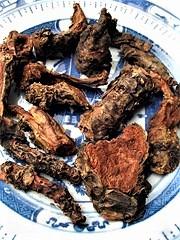Rhodiola
- Name
- Origin
- Where Does It Grow?
- Nature and Flavor
- Identified Active Components / Major Chemical Constituents
- Drug Actions in TCM
- Traditional Uses in TCM
- Pharmacological Actions
- Toxicology
- Administration and Dosage
- Adverse Effect, Side Effects and Cautions
- References
Name
Latin Name: Rhodiola
Common Name: Rhodiola / roseroot / arctic root / golden root
Chinese Name: 紅景天
Pinyin Name: hong jing tian
Origin
Rhodiola is a kind of bush that belongs to family Crassulaceae. The root, rhizome or the whole herb is used for medicinal proposes. 8
Where Does It Grow?
|
Scientific Names |
Chinese Names |
Productive Areas |
|
Rhodiola crenulata (Hook.f.etThoms.) H.Ohba |
寬瓣紅景天 / 圓齒紅景天 / 蘇羅馬保 |
Sichuan, Yunnan, and Tibet |
|
Rhodiola sachalinensis A. Bor |
高山紅景天 |
Heilongjiang and Jilin |
|
Rhodiola sacra (Prain ex Hamet.) S. H. Fu |
全瓣紅景天 / 紅景天 /掃羅馬爾布 / 參嘎 |
Tibet and Yunnan |
|
Rhodiola algida (Ledeb) Fisch.et Mey.var.tangutica (Maxim.) S. H. Fu |
紅景天 |
Ningxia, Gansu, Qinghai and Sichuan |
|
Rhodiola dumulosa (Franch.) S. H. Fu |
鳳尾七 / 鳳尾草 / 霧靈紅景天 |
Jilin, Inner Mongolia, Hebei, Shanxi, Gansu, Qinghai, Hubei and Sichuan |
|
Rhodiola kirilowii (Regel.) Maxim. |
大株紅景天 / 獅子七 /獅子草 |
Tibet, Yunnan, Sichuan, Shanxi, Gansu, Qinghai, Hebei and Xinjiang |
|
Rhodiola henryi (Diels) S. H. Fu |
豌豆七 |
Shanxi, Gansu, Hebei, Hubei and Sichuan |
|
Rhodiola yunnanensis (Franch.) S. H. Fu |
豆葉七 |
Hubei, Sichuan, Guizhou, Yunnan and Tibet |
|
Rhodiola rosea L. |
紅景天 / 玫瑰紅景天 |
Xinjiang, Shanxi and Hebei |
In the Pharmacopoeia of People's Republic of China (2005 Edition) - Part I, the recorded species is Rhodiola crenulata (Hook.f.etThoms.) H.Ohba, and the medicinally used part is the dried root and rhizome.
Nature and Flavor
Rhodiola is mild in nature, and sweet and bitter in flavor. It mainly manifests its therapeutic actions in the Lung Meridian and Heart Meridian. 7
Identified Active Components / Major Chemical Constituents

Drug Actions in TCM
Rhodiola replenishes qi (vital energy), activates blood circulation, unblocks blood vessels and smooths asthmatic conditions. 7Traditional Uses in TCM
Pharmacological Actions
Kunming mice and Wistar rats were used to test the anti-oxidation effect of the butanolic extracts of Rhodiola crenulata. Different concentrations of butanolic extract of Rhodiola crenulata (1, 3, 12.5 and 50ug/ml) inhibit liver microsome peroxidation in the Wistar rat model induced by FeS04/Cys, the inhibition is dose-dependent. 12.5ug/ml butanolic extract of Rhodiola crenulata has a similar anti-oxidation effect to the same concentration of vitamin E. The extract can also inhibit haemolysis caused by hydrogen peroxide (H2O2) and scavenge DPPH free radicals. This demonstrated the anti-oxidation effect of the Rhodiola crenulata extracts. 2
2. Anti-hypoxia and Anti-fatigue
3. Anti-radiation
5. Regulation of blood glucose level (clinical study)
Toxicology
Administration and Dosage
Rhodiola is usually used 3~9g each time for decoction. The herb is also made in syrup, tincture, pill and powder preparations.8
Adverse Effect, Side Effects and Cautions
References
- 盧永昌、林鵬程、康吉森。大花紅景天抗氧化作用的研究。中國油脂 30(6): 40-41 (2005)
- 孫芳雲、王金華、杜冠華、等。大花紅景天的抗氧化性溶血作用研究。中藥藥理與臨床 22: 118-120 (2006)
- 陳玉滿、陳江、毛光明、等。大花紅景天的抗氧化作用的研究。浙江預防醫學 19(1): 92-93 (2007)
- 仝國輝、譚壯生、楊慶。大花紅景天的抗輻射損傷作用。衛生毒理學雜誌 18(3): 183-184 (2004)
- 朱光華、王致、郝一彬、等。大花紅景天對苯血液毒性干預的探討。中國職業醫學 33(1):15-18 (2006)
- 范羽豐、譚蓉、江鈴。大花紅景天以生活方式對二十七例二型糖尿病患者的治療評價。中國現代葯物應用 1(6): 10-11 (2007)
- Pharmacopoeia of People's Republic of China (2005 Edition) – Part I
- Herbology of China -- http://www.zysj.com.cn/zhongyaocai/zhonghuabencao/index.html
- Preliminary Discussion on Medicinal Use of Rhodiola and its enlisted in Pharmacopoeia of PRC. http://www.39kf.com/cooperate/lw/zxjh/02/2006-09-18-263731.shtml
- Bao Wenfang et al (edited), The Anti-fatigue Effect of Rhodiola Plant, People's Military Medical Press, 2004.


